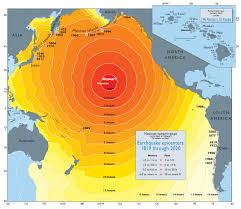🌍 A Powerful Earthquake Rocks Russia’s Kamchatka Peninsula
On July 30, 2025, a massive magnitude 8.0 earthquake struck off the eastern coast of Russia, near the Kamchatka Peninsula, a seismically active region known as part of the Pacific Ring of Fire.
According to the United States Geological Survey (USGS), the quake occurred at a depth of around 35 kilometers, causing significant tremors felt across the Russian Far East. The epicenter was located offshore, raising immediate concerns about tsunami formation in the Pacific Ocean.
🚨 Tsunami Watch Issued for Pacific Regions
Soon after the quake, the Pacific Tsunami Warning Center (PTWC) issued a Tsunami Watch for various regions including Hawaii, Japan, and the West Coast of North America.
Authorities in Russia activated local evacuation procedures in parts of Kamchatka and the Kuril Islands, urging residents in low-lying coastal areas to move to higher ground.
So far, no major tsunami wave has been confirmed, but ocean monitoring stations have detected unusual wave activity. Officials are closely watching the situation to determine if a tsunami warning will escalate.
📌 What Is a Tsunami Watch?
A tsunami watch means that a tsunami is possible based on preliminary earthquake data. It is not a guarantee that one will happen, but it serves as a critical early alert for people in coastal regions to stay vigilant and be prepared to act.
If conditions worsen or a wave is detected, a tsunami warning will be issued, signaling imminent danger.
🔍 Why Is the Kamchatka Region So Prone to Quakes?
Russia’s Kamchatka Peninsula is one of the most earthquake-prone areas in the world. It lies on the convergent boundary between the Pacific Plate and the North American Plate, making it highly susceptible to seismic activity.
The region has a history of producing large undersea quakes—the type most capable of generating tsunamis.
🏝️ Impact on Hawaii and Pacific Nations
Although Hawaii is thousands of miles away, undersea earthquakes of this magnitude can still send tsunami waves across the entire Pacific Ocean. That’s why the Hawaii Emergency Management Agency has placed the islands under a Tsunami Watch and advised residents to:
- Monitor local news updates
- Prepare emergency kits
- Avoid beaches and coastal areas until further notice
As of now, no evacuations have been ordered in Hawaii, but the situation remains fluid.
🧭 Global Reactions and Preparedness
Countries around the Pacific—especially Japan, Indonesia, and the western U.S.—are closely monitoring this event. Emergency services are on standby, and tsunami early-warning systems are actively tracking sea-level changes.
This event also serves as a reminder of the importance of earthquake preparedness in vulnerable zones. Nations are reviewing their disaster response protocols to ensure readiness.
📝 Final Thoughts: Stay Alert, Stay Safe
While there’s no immediate threat of destruction as of this writing, the Russia earthquakes tsunami warning is a developing situation. It highlights just how interconnected our world is when it comes to natural disasters.
If you’re in a coastal area—especially around the Pacific Rim—keep your phone charged, follow your local emergency alerts, and have a plan in place.
Disasters can strike without warning, but preparedness can save lives.


Leave a Reply